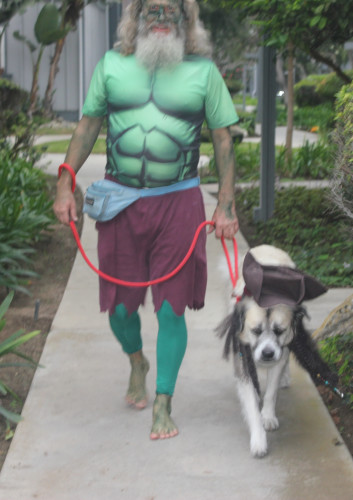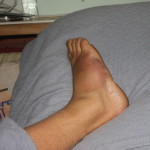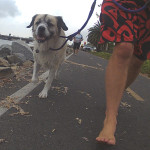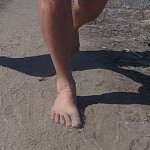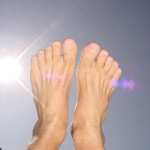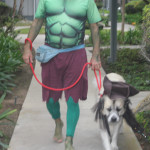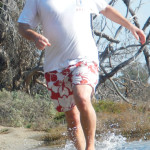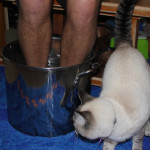Contents
Introduction
I was going to wait until after the 2014 November lunchtime Boeing 5K race to write this final report. But, I didn’t race that day. Also, I wasn’t able to race in the December lunchtime Boeing 5K (it’s a monthly event). So, I guess I may as well write this up now… now being nearly the end of March.
So, after “preaching” for decades about the benefits of barefoot running, including injury reduction (not absolute prevention), on 2014 May 31 Saturday, I broke my foot!
I put “Final” in quotes, because I still haven’t really “raced” on it (though I did do a few “races” since – walking the first two, and slow running the third), and many who have had similar injuries have warned me that it could be years before it was fully healed…
Recap, How I Broke my Foot
It was my Saturday regular run, and I had already finished running a mile and a half, and was warmed up, and feeling pretty good, running fast on a short downhill, which was cambered a bit to the right, and my foot rolled inward as my ankle twisted toward the down-side of the camber. It was disappointing, as I was hoping to build my distances back up, and my 2-month summer break from work was just beginning. But, it was the “perfect” time to break my foot -if I was going to break my foot. And after some thought about the history of that foot and ankle, it probably was inevitable.
Sadly, although I was shooting some video of my feet during parts of my run, I had just stopped shooting in time to miss the moment when the foot actually broke!
Then I still had to walk – very very gently – the mile and a half back home. After a few days of rest, frozen berries or peas (ice is too cold), compressing (in short intervals – I don’t like too much restriction), and elevation (or was that “exercise”?) R.I.C.E., I went to the doctor and got my foot X-rayed. The fifth metatarsal was broken – not displaced, simply cracked. A very common injury, even for people in shoes. Also not exactly the same injury people often suffer when trying to begin running barefoot in minimalist shoes
History

1990 August 25 wedding, barefoot on the rocks
In 1990 in mid August, 2 weeks before my wedding (1990 August 24), I was racing with a co-worker down 4 flights of stairs. At the very bottom, I made a sharp ninety degree turn, and rolled my ankle, spraining it badly enough that I was just barely not limping at my wedding 2 weeks later.
By the way, we finished in a tie! (the race down the stairs … and I suppose perhaps the wedding too)
Some years later, I noticed a bump on top of my foot behind the smallest toe on my right foot. Over the past few years of running less and less (being older and busier with other things), the bump started changing, sometimes fading away almost completely, then popping back up in a slightly different location (or maybe I was just looking at it from a different perspective).
I suspect that I may have broken the metatarsal in that previous incident, and the bump may have been a build-up of calcium or scar tissue to help hold the bone together, allowing me to run tens of thousands of miles, 79 barefoot marathons, over 400 races total during those couple of decades, with no obvious problems.
Pretty Much Fine Now, Thank You Very Much
Whatever happened all those years ago, and whether it had anything to do with the recent and more obvious break, my foot is now, pretty much fine. Still have not really raced on it yet – racing has become way to expensive anyway, and I’ve been pretty busy at work to get to the free second-Monday-of-each-month lunch-time 5K (one of my favorite races). I have run the 7 miles home from work a few times, with no other problems than being a bit tired, and sore (due to being a bit out-of-shape).
Broken Feet and Fake “Barefoot” Running
Some people may have questions about the relationship between breaking feet and barefoot running. Keep in mind that I have been running barefoot for nearly 60 years, with many fewer, and less sever injuries than many shod runners who haven’t been able to run for half that length of time. And many of my shod friends have suffered similar injuries in shoes, at much younger ages.
My broken foot was a “traumatic” injury – it happened due to a sudden strain on the bone. In this case a severe twisting motion. This type of injury is quite common, not only in runners in shoes, but walkers, and even people who aren’t necessarily very active.
The more common broken foot occurrences among runners are stress fractures. These often suffered by those who have tried to begin “barefoot” running in shoes (“barefoot shoes”??). Especially after beginning with what we often refer to as “too much, too soon”.
Stress fractures occur gradually caused by apparently minor pressure on the feet, but repeated with each and every step over a period of several weeks or longer. It’s a bit like bending a piece of metal to break it. It takes a lot of force to snap metal quickly in half. But, bending the metal, many many repeated times and with much less force over time will result in weakening and eventually breaking the metal.
Wearing shoes – ESPECIALLY minimalist or “barefoot” shoes – allows people to put more of these repeated types of stress on their feet without realizing it, making it more likely that they will suffer from this type of stress fractures. At least traditional running shoes provide some support to counter this sort of bad running technique. Still, it’s so much safer and easier, in the long run, to run or walk with gentle and efficient running technique.
Many when they hear the “too much, too soon” phrase, assume that means that one simply needs to strengthen the feet gradually to handle the “abuse” of running barefoot.
Virtually every “barefoot” runner I have talked with (after seeing them in the “boot”), injured themselves because they tried to do “too much too soon”. But it isn’t really as simple as too much repeated strain on feet that are not strong enough to take that strain. But, the question isn’t simply a case of weak feet not being ready for the “abuse” of “barefoot” running. It’s more a question whether or not it’s necessary to put that much strain on the feet. Reducing these stresses, is almost as simple as being aware of just how much strain we are putting on our feet. Sensitive bare soles are embedded with many nerve endings for precisely this reason.
Not Every Barefoot or Minimalist Runner Breaks Their Feet
Just to be fair, I have heard from a few people who have had great success with minimalist footwear. I presume this is because they took the time to build those foot muscles, and hopefully even did some work on trying to improve technique. GREAT! (for you). But most people don’t have that kind of patience, and if they are convinced by advertising that says they can get the “same benefits”, and “reduced injuries” without the “pain” of actually being barefoot (which should read, “without the feedback to help improve your technique”), then of course, many obviously have BOUGHT (literally) into that fallacy.
What’s really cool, is the number of people who went this route, and then for one reason or another finally did go literally barefoot, and realized that they got exponentially more feedback from bare soles, than from even the thinnest soled footwear. That feedback gave them the information needed to make the most subtle improvements to their running technique, which they were not aware of while running in minimalist footwear. Note: Some of these subtle improvements are fine-tuned precisely for your individual body, the way it is shaped and works today (and our body changes from day-to-day, year-to-year). These subtleties in technique are something nobody can observe, or help you correct, from outside your body, nor without the advantage of bare soles being able to feel how they are interacting with the ground with each and every step!
In my opinion, if you get the technique correct (easy, gentle, and efficient), foot strength isn’t going to be all that important for normal daily walking and running around your neighborhood (unless you live on the side of the Himalayan Mountains or something like that). Now, of course, your foot strength will increase, as you walk and run barefoot, especially if you listen to the warnings from your bare soles telling you to walk and run gently, easily, and efficiently while increasing speed and distance gradually. It’s when we ignore or block these messages, that we don’t even realize we are causing damage, until the bone snaps. Then after long period of healing (which I have now experienced first hand), we try to begin again, and again, without direct feedback from our soles, many runners just keep repeating this cycle, until they finally just give up on running, or discover barefoot running!
And one other thing to help avoid the dangerous too-much, too-soon syndrome, every outing should NOT be more difficult than the last. 90% of our outings should leave us feeling refreshed, not beaten down! And again, sensitive soles in the beginning also encourage us to limit our time, distance and speed until we get better at running gently.
As evidence that perfect and strong feet are not as important as many presume, I present myself and the fact that I have been running barefoot for the past 2 and a half decades possibly with an already broken metatarsal, which had not healed properly (until recently) … and probably caused originally while wearing running shoes!
Gallery
- Ken Bob’s broken foot, after walking on it for 1.5 miles to get back home.
- Ken Bob’s broken foot – the next day the bruising was a much prettier color.
- Ken Bob’s broken foot – 2 weeks later I tried walking in shoes, but the instability made my foot hurt worse than walking barefoot.
- Ken Bob’s broken foot – 5 weeks later, Surf City 5k, 2014 July 4. Walking with Herman, and one of Herman’s girlfriend’s moms.
- Ken Bob’s broken foot – 6 weeks later – Boeing 5K with Herman, mostly walking (Herman did some swimming too)
- Ken Bob’s broken foot – 3 months later, on the same trail where my foot broke.
- Ken Bob’s broken foot – 3 months later. Still a bump on the outside top of the right foot
- Ken Bob’s broken foot – 5 months later, Halloween. Should I be worried about the green color of myfoot?
- Ken Bob’s broken foot – 7 months later, splashing good time!
- 1990 August 25 wedding, barefoot on the rocks
